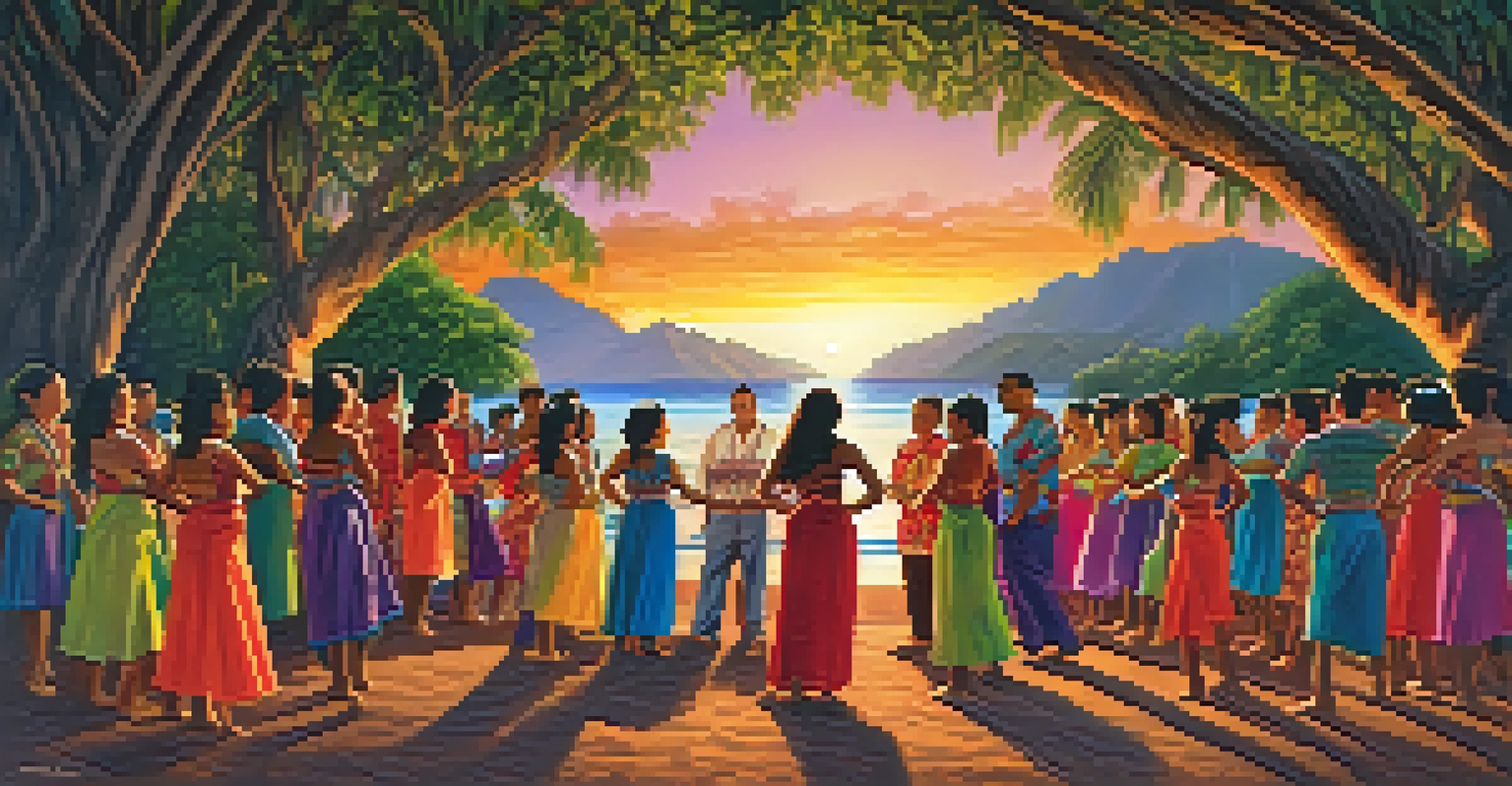Hawaii's Annexation: Politics and Controversy in 1898

Understanding the Context of Hawaii's Annexation
In the late 19th century, Hawaii was a strategic location for trade and military operations in the Pacific. The islands were rich in sugar production, making them appealing to American businessmen and politicians. As the U.S. expanded its influence across the globe, Hawaii became a focal point for American imperial ambitions.
The most important thing about the annexation of Hawaii is that it was a violation of the sovereignty of the Hawaiian people, which has had lasting effects on their identity and rights.
Hawaii's political landscape was changing, with growing tensions between native Hawaiians and foreign interests, particularly from the United States. A group of American planters and business leaders began to exert significant influence on the Hawaiian monarchy, pushing for closer ties with the U.S. This set the stage for the eventual annexation, which would alter the islands' future forever.
Understanding these dynamics is crucial to grasping the controversy surrounding Hawaii’s annexation. It wasn't just a simple takeover; it was a complex interplay of economic interests, political maneuvering, and cultural upheaval that would lead to deep and lasting impacts on Hawaiian society.
Key Players in the Annexation Debate
The annexation of Hawaii was not a decision made in isolation. Key players included American business leaders, politicians, and native Hawaiians, each with their own agendas. Notably, figures like Sanford Dole, a prominent sugar planter, played a pivotal role in advocating for annexation, believing it would secure economic benefits for American interests.

On the other side of the equation were native Hawaiians, many of whom opposed the annexation and sought to preserve their sovereignty. Queen Liliʻuokalani, the last reigning monarch of Hawaii, was a significant figure in this resistance. She fought to restore the power of the Hawaiian monarchy and protect the rights of her people, emphasizing the cultural and historical significance of the islands.
Economic Interests Fueled Annexation
Hawaii's strategic location and rich sugar production attracted American business leaders, leading to significant political influence and eventual annexation.
This clash of interests illustrates the complexity of the annexation debate. It wasn’t merely a geopolitical move; it involved deep-rooted issues of identity, sovereignty, and economic control that would resonate for generations.
The Role of American Imperialism in 1898
American imperialism was a driving force behind Hawaii's annexation. In the late 1800s, the U.S. was expanding its reach, motivated by a desire for new markets and military bases. Hawaii was seen as a strategic gateway to Asia, making its annexation a crucial step for American interests.
Hawaii's annexation was not just a political act, but a profound cultural upheaval that continues to resonate in the lives of native Hawaiians today.
The Spanish-American War in 1898 further accelerated this ambition, as the U.S. sought to establish a stronger presence in the Pacific. The islands provided an ideal location for coaling stations and naval bases, emphasizing their military significance. This militaristic perspective overshadowed the voices of native Hawaiians and their concerns.
Thus, American imperialism not only shaped the political landscape but also created a narrative that prioritized expansion over the rights of indigenous populations. This led to significant consequences for Hawaii and its people, whose sovereignty was overshadowed by geopolitical strategies.
The Annexation Resolution: A Turning Point
The annexation of Hawaii was formalized with the Newlands Resolution in July 1898, passed by Congress. This legislation was controversial, as it was seen by many as a unilateral decision that disregarded the wishes of the Hawaiian people. Despite the protests, the resolution ultimately facilitated Hawaii's incorporation into the United States.
The process itself raised questions about the legitimacy of the annexation. Many argued that it was accomplished without the consent of native Hawaiians, which undermined the principles of democracy and self-determination. This debate continues to fuel discussions about U.S. imperialism and its implications for indigenous rights.
Cultural Erosion After Annexation
The influx of American settlers resulted in the erosion of traditional Hawaiian customs and practices, impacting language and cultural identity.
The Newlands Resolution marked a significant turning point in Hawaiian history. It transitioned Hawaii from a sovereign nation to a territory of the United States, fundamentally altering its political and cultural landscape.
Response from Native Hawaiians and Allies
In the wake of the annexation, native Hawaiians voiced their discontent and resistance. Many viewed the takeover as a violation of their rights and an affront to their sovereignty. Organizations like the Hawaiian Patriotic League emerged, advocating for the restoration of the monarchy and the rights of the Hawaiian people.
Allies from various backgrounds also joined the fight against annexation. Supporters included individuals who recognized the importance of cultural preservation and self-determination. Their solidarity highlighted the widespread discontent with U.S. policies and the ongoing struggle for Hawaiian rights.
This response illustrated the resilience of the Hawaiian spirit in the face of political upheaval. The resistance movement not only sought to reclaim sovereignty but also aimed to preserve the unique cultural identity of Hawaii amidst growing American influence.
Cultural Impacts of Annexation on Hawaii
The annexation of Hawaii led to profound cultural changes that reshaped the islands. The influx of American settlers and businesses resulted in the erosion of traditional Hawaiian customs and practices. Many native Hawaiians experienced a loss of their language, cultural heritage, and ways of life, as Western values began to dominate.
Education and religion also underwent significant transformations. Missionaries played a crucial role in reshaping Hawaiian society, often promoting Western ideals at the expense of indigenous beliefs. This cultural shift caused tensions and a sense of dislocation among native Hawaiians, who struggled to reconcile their identity with the changes imposed upon them.
Legacy of Controversy and Resistance
The annexation has led to ongoing debates about sovereignty, self-determination, and the rights of native Hawaiians, highlighting historical injustices.
The cultural impacts of annexation continue to be felt today. Efforts to revitalize the Hawaiian language and traditions reflect a broader movement to reclaim and celebrate a rich cultural heritage that has endured despite historical challenges.
Legacy of Hawaii's Annexation: Ongoing Controversies
The legacy of Hawaii's annexation remains a contentious topic, with ongoing debates about its implications. Many argue that the annexation was a blatant act of imperialism that disregarded the rights of the Hawaiian people. This perspective calls for a reassessment of historical narratives and recognition of the injustices faced by indigenous populations.
Contemporary discussions often focus on issues such as sovereignty, reparations, and the restoration of rights for native Hawaiians. Movements advocating for self-determination and cultural revitalization have gained traction, as many seek to address historical grievances and promote greater awareness of Hawaiian issues.

Ultimately, the annexation of Hawaii in 1898 serves as a reminder of the complexities of American history and its impact on indigenous cultures. Understanding this legacy is essential for fostering dialogue and reconciliation in a contemporary context.